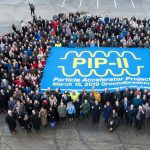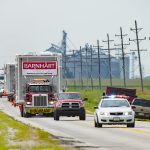Deep Underground Neutrino Experiment
From Discover, March 12, 2019: Fermilab, along with the Sanford Underground Research Facility in South Dakota, is starting a new project called the Deep Underground Neutrino Experiment, or DUNE. The goal is to track and study shadowy neutrinos like never before. Fermilab scientists Deborah Harris and Angela Fava discuss the experiment.
From Big Picture Science, Feb. 18, 2019: Fermilab scientist Anne Schukraft is interviewed in this podcast episode about ghostly particles called neutrinos — intriguing partly because they came decades before we had the means to prove their existence.
From El Comercio, Feb. 18, 2019: Los neutrinos, esas part&iaacute;culas subatómicas, la más pequeñas y abundantes de la naturaleza, podrían ayudar a entender por qué el universo está hecho de materia.
From The Bogota Post, Feb. 14, 2019: Building change stems from building new role models to get women out of unpaid labor roles and into the country’s laboratories and management boards. Role models include on of the scientists on the Deep Underground Neutrino Experiment.
From Saense, Feb. 14, 2019: Uma parte vital de um dos maiores experimentos da física de partículas atual foi desenvolvida no Brasil. O Arapuca é um detector de luz a ser instalado no Deep Underground Neutrino Experiment — projeto que busca descobrir novas propriedades dos neutrinos, partícula elementar com muito pouca massa e que viaja a uma velocidade muito próxima à da luz.
From FAPESP, Feb. 13, 2019: Uma parte vital de um dos maiores experimentos da física de partículas atual foi desenvolvida no Brasil. O Arapuca é um detector de luz a ser instalado no Deep Underground Neutrino Experiment — projeto que busca descobrir novas propriedades dos neutrinos, partícula elementar com muito pouca massa e que viaja a uma velocidade muito próxima à da luz.
From Aurora Beacon-News, Fermilab scientists and engineers are hoping to understand neutrinos — tiny particles that many feel hold the key to answering many questions about the universe — and are using a very large thermometer to do it.
From University of Missouri – Kansas City’s University News, Feb. 6, 2019: Sánchez, a scientist at Iowa State University, is a part of Fermilab’s NOvA neutrino experiment and the Deep Underground Neutrino Experiment. She also co-leads the ANNIE experiment at Fermilab.
Physicists often find thrifty, ingenious ways to reuse equipment and resources. What do you do about an 800-ton magnet originally used to discover new particles? Send it off on a months-long journey via truck, train and ship halfway across the world to detect oscillating particles called neutrinos, of course. It’s all part of the vast recycling network of the physics community.


